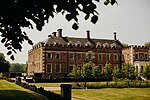Knowlton Circles
Archaeological sites in DorsetBronze Age sites in DorsetBuildings and structures in DorsetEnglish Heritage sites in DorsetHenges ... and 1 more
Tourist attractions in Dorset

Knowlton Circles (also known as Knowlton Henges or Knowlton Rings) are a complex of henges and earthworks in Knowlton, Dorset, England. The henge enclosing Knowlton Church is the best known and best preserved, but there are at least two other henges in the vicinity as well as numerous round barrows.
Excerpt from the Wikipedia article Knowlton Circles (License: CC BY-SA 3.0, Authors, Images).Knowlton Circles
Lumber Lane,
Geographical coordinates (GPS) Address External links Nearby Places Show on map
Geographical coordinates (GPS)
| Latitude | Longitude |
|---|---|
| N 50.891972 ° | E -1.967389 ° |
Address
Knowlton Church and Earth Works
Lumber Lane
BH21 5LT , Woodlands
England, United Kingdom
Open on Google Maps








